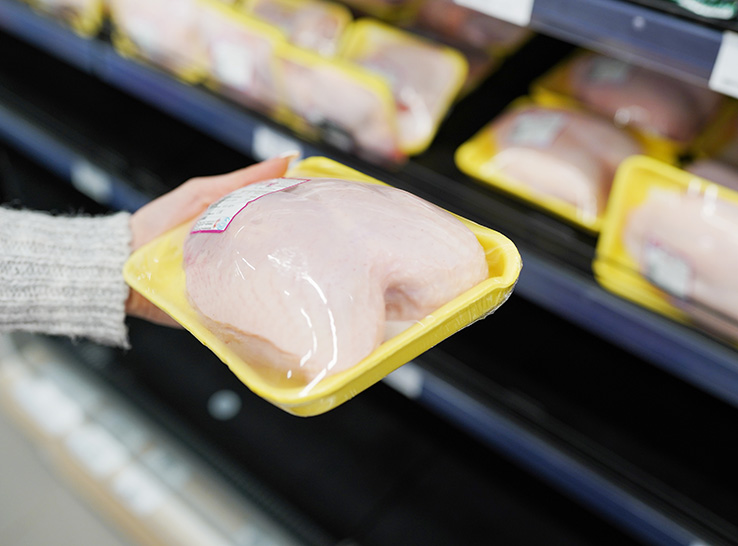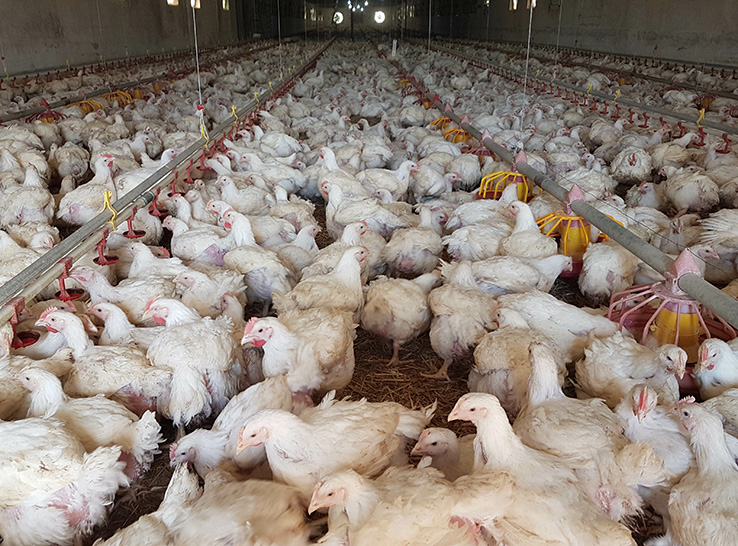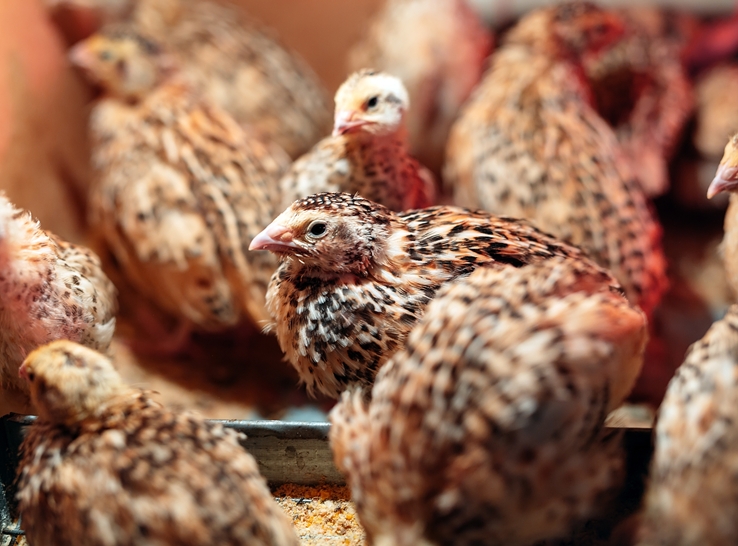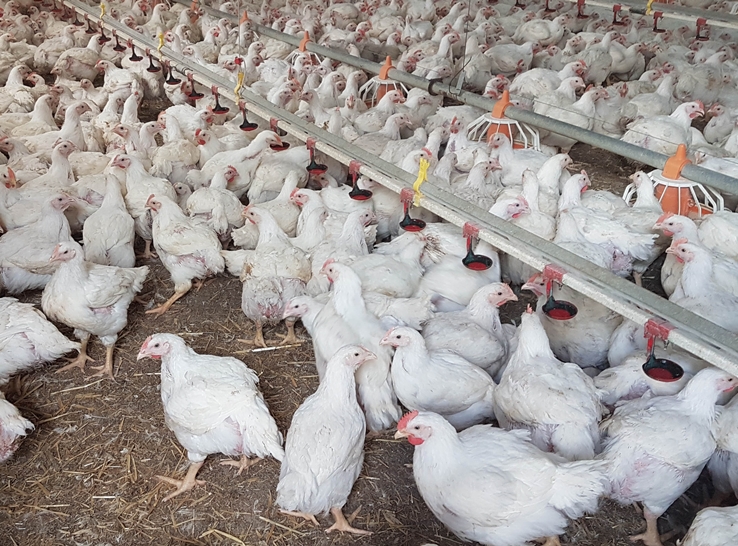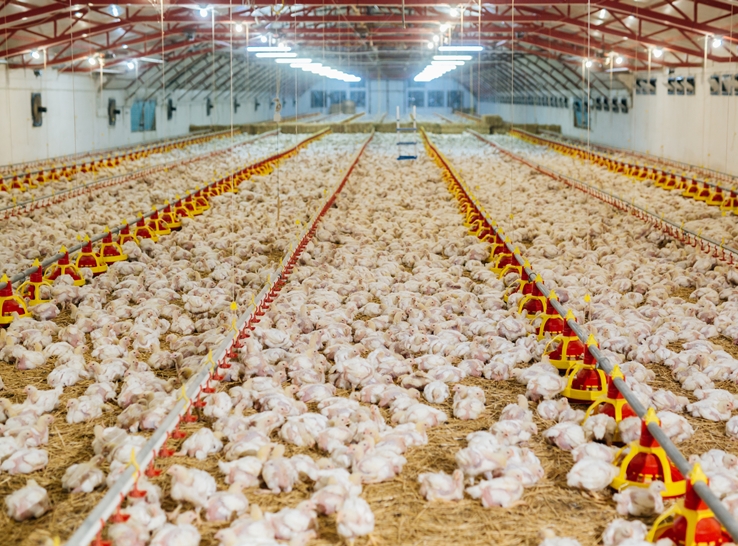By Prafulla Regmi, PhD, University of Georgia
Stocking density is typically defined in terms of the number of birds per unit area or the amount of space provided on per bird basis. In commercial production, stocking density of a broiler flock is calculated based on target market weight by accounting for the number of chicks placed initially and the average flock mortality. This practice is not always ideal as maintaining low mortality can sometimes lead to overstocking later in the bird’s lives, which can pose welfare issues.
Stocking density is a key determinant of profits from a broiler operation as revenues per unit of space increase with increasing stocking density. However, overcrowding due to high stocking density can lead to negative behavior and welfare consequences including gait disorders, skin lesions, and decreased bouts of resting behaviors. In this article, we will discuss the implications of high and low stocking densities on broiler behaviors.
Stocking density recommendations
Although stocking density is important for welfare and production, no universal stocking density recommendations exist for commercial broilers. Various countries and organizations have established guidelines and recommendations for stocking density.
- Canada recommends not exceeding 31 kilograms per square meter.
- The National Chicken Council in the United States suggests a range of 32 to 44 kilograms per square meter based on bird weight.
- The European Union sets a stocking density limit of 33 kilograms per square meter, which can be increased to 39 or 42 kilograms per square meter if specific requirements are met according to their regulations.
- Certification programs like GAP and Certified Humane have specific stocking density requirements.
Behavioral impacts of stocking density
Several studies have investigated the effects of stocking density on broiler behavior, with varying results. Some findings suggest that locomotive behaviors and litter-directed behaviors, such as foraging and dustbathing, may decrease with increasing stocking density, while others do not show consistent trends in these behaviors.
Resting and other behaviors:
One commonly observed effect of increasing stocking density is the disturbance of resting or interruptions in resting bouts. While these disturbances typically do not result in aggression, they can lead to carcass damage due to scratches on the inactive birds’ backs by active birds when they are disturbed. Other research did not find stocking density to significantly impact the frequency of preening, standing, and foraging behaviors in broilers.
Feed intake:
High stocking density can reduce feed intake in broilers which was considered to be the result of limitation of feeder space. However, reduction in feed intake might not be related to the competition at the feeder. Overall feeding behavior (time spent at the feeder) does not seem to change with a change in stocking density. Feeder to bird ratio is generally maintained at 40 to 100 birds per feeder in commercial production. Any addition of feeder space should be accompanied by an increase in total floor space.
Fear and anxiety related behaviors:
Effects of stocking density on fear and anxiety-related tests (tonic immobility and novel object tests) have been inconsistent. Several experiments failed to observe any relation between stocking density and fear related behaviors whereas others have reported an increase in fear and anxiety with increased stocking density (when the density incerased from 18 to 22 birds per square meter). On the other hand, young broilers (12 days old) can be less fearful when reared at high stocking density (42 kilograms per square meter).
Breed effects:
The effects of stocking density on broiler behavior also appear to be influenced by breed. This could be due to the differences between fast-growing and slow-growing broiler lines. Slow-growing broilers, defined as those gaining less than 50g per day, exhibit more walking, standing, foraging, and aggressive behavior compared to their fast-growing counterparts. They also engage in less eating and sitting behavior. Results regarding fear tests have been inconsistent, but slow-growing lines generally display more play behavior, such as frolicking and sparring.
Environmental management:
Stocking density alone is not sufficient to ensure higher standards of animal welfare. Environmental management is crucial in conjunction with stocking density to maintain optimal welfare conditions. High stocking densities may lead to decreased litter quality and air quality. Environmental management can impact up to 6 times more variables related to broiler welfare and behavior than stocking density alone.
Behavioral model to determine stocking density:
In order to accurately predict the optimal stocking density for broilers, some recent models have integrated specific behaviors such as wing flapping, leg stretching, dustbathing, preening, and walking. These models take into consideration the distances between individual broilers for each behavior. However, to ensure the effectiveness of such models, it is essential for them to consistently define behaviors and incorporate variations in behavior expression throughout the day and night, accounting for diurnal and circadian patterns.
Potential solutions to reduce negative impacts of high stocking density
Probiotics, prebiotics and synbiotics – Use of probiotics, prebiotics, and synbiotics can improve gastro-intestinal health of broiler chickens and help maintain litter quality. Some of these products could also aid in combating stress among broilers by contributing in the production of several neurotransmitters.
Dietary supplementation of sodium bentonite – Can minimize nitrogen and litter moisture by aiding protein digestibility.
Conclusion
Stocking density has diverse effects on broiler welfare and behavior. It can influence locomotive behaviors, litter-directed behavior, fear and anxiety-related behaviors, and breed-specific behaviors. Environmental management should be carefully implemented alongside stocking density to optimize broiler welfare and production outcomes.
Resources
- Anderson MG et al. Effect of Environmental Complexity and Stocking Density on Fear and Anxiety in Broiler Chickens. Animals (Basel). 2021 Aug 12;11(8):2383.
- EFSA AHAW Panel (EFSA Panel on Animal Health and Animal Welfare). Scientific Opinion on the welfare of broilers on farm. EFSA Journal 2023;21(2):7788, 236 pp. https://doi.org/10.2903/j.efsa.2023.7788
- Estevez I. Density allowances for broilers: where to set the limits? Poultry Sci. 2007;86(6):1265-1272.
- Li et al. Effect of feeder space on broiler feeding behaviors. Poult Sci. 2021;100(4):101016
- Sugiharto S. Dietary strategies to alleviate high-stocking-density-induced stress in broiler chickens – a comprehensive review. Arch Anim Breed. 2022;65(1):21-36. doi: 10.5194/aab-65- 21-2022. PMID: 35106363; PMCID: PMC8795885.
- Van der Eijk J et al. Reducing stocking density benefits behaviour of fast- and slower- growing broilers. App Anim Behav Sci. 2022; 257:105754.
- Weimer SL et al. Differences in performance, body conformation, and welfare of conventional and slow-growing broiler chickens raised at 2 stocking densities. Poult Sci. 2020;99(9):4398-4407.
To view the full Poultry Extension Collaborative newsletter, Vol 39, click here.
Editor’s note: Content on Modern Poultry’s Industry Insights pages is provided and/or commissioned by our sponsors, who assume full responsibility for its accuracy and compliance.

